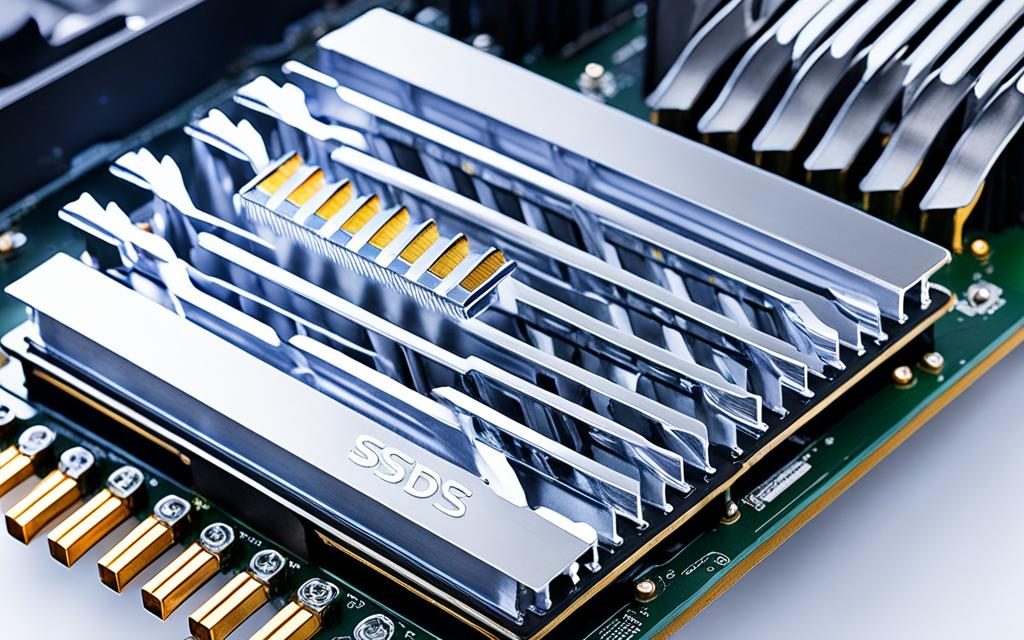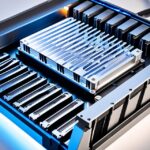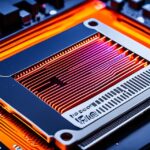Table of Contents
The evolution of storage technology brings up an important question: is an SSD heatsink necessary? Solid-State Drives (SSDs) are known for their fast speeds, especially with the NVMe protocol over PCIe Gen4. This allows for quick, parallel data operations. However, faster speeds can lead to heating issues. When SSDs are used for tasks like gaming or video editing, they get warm. Without SSD cooling, SSDs may slow down to avoid getting too hot. This process is called thermal throttling. So, it’s vital to understand how to manage heat in SSDs. Innovations like heatsinks are designed to improve efficiency and make SSDs last longer. This article explores the importance of cooling for SSDs. It explains why cooling is key in high-performance settings today1.
With more powerful SSDs being developed, choosing a cooling solution is getting more crucial. A heatsink can prevent your SSD from getting too hot. It also helps keep your SSD working well. This discussion is very important for anyone who wants to get the most out of their storage devices. This is especially true as high-performance SSDs become more common.
Key Takeaways
- SSDs generate heat during intensive tasks, making thermal management crucial for performance.
- Heatsinks significantly impact SSD operating temperatures, preventing performance throttling.
- SSD heatsinks are essential in applications such as gaming, video editing, and design workflows.
- M.2 SSDs benefit from efficient heat dissipation, particularly when using NVMe and PCIe Gen4 technology.
- Incorporating a heatsink can enhance the longevity of your SSD.
The Importance of Cooling for SSDs
Understanding SSD heat generation is crucial for any high-performance computer. When data moves and gets processed, the SSD’s internal parts, like the controller chip, DRAM, and NAND flash memory, create a lot of heat. It’s important to handle this heat well to keep the drive working well for a long time.
How SSDs Generate Heat
SSDs get really hot when doing tough tasks. Things like moving lots of data or using many apps at once can make them much hotter. Although SSDs can work without a heatsink, having proper cooling is key to avoid slowing down, especially when they’re pushed hard.
The Role of the Controller Chip, DRAM, and NAND Flash
The controller chip is important for controlling data flow and affects how hot the SSD gets. The DRAM holds data for a short time but can make the SSD hotter when it’s working hard. The NAND flash, where data is stored, also adds to the heat. That’s why games on consoles like PlayStation 5 need SSDs with good cooling. They use a fast PCIe Gen 4 M.2 NVMe drive that must stay cool, as shown in the need for heatsinks for the best performance2.
| Component | Function | Heat Contribution |
|---|---|---|
| Controller Chip | Manages data flow | High during intensive tasks |
| DRAM | Temporary storage | Moderate to high during data transfers |
| NAND Flash | Permanent data storage | Significant during read/write operations |
Using a heatsink or similar cooling devices helps control the temperature of these parts. This not just keeps the SSD cool but also makes it last longer. Proper heat management is essential for reliable performance3.
Do I Need a Heatsink for My SSD?
To decide if your SSD needs a heatsink, look at how it works and its performance. SSDs need to stay cool to work well. They usually work best from 30°C to 65°C. However, NVMe SSDs can get hotter than 80°C when working hard4. When they get too hot, they might slow down, lose data, or damage data4.
Understanding SSD Temperature Ranges
Many M.2 NVMe SSDs, like the CORSAIR MP600 PRO LPX, should stay around 70°C5. SSD controllers can handle more heat than the memory parts, sometimes above 100°C5. But if it gets too hot, the SSD will slow down until it cools down. Keeping it cool is very important.
Factors Influencing the Need for a Heatsink
Whether you need a heatsink depends on several things. More data moving means more heat. So powerful apps might need extra cooling. The airflow in your PC is also crucial—it can keep the SSD cool on its own. But some motherboards, especially for faster SSDs like the CORSAIR MP700, have coolers that might not be big enough45. So, think about your PC’s build and what you do with it when considering a heatsink.
Types of Heatsinks and Cooling Solutions
It’s crucial to know about SSD cooling solutions to keep your drives working well and lasting long. These solutions split into two kinds: passive cooling and active cooling.
Passive vs. Active Cooling
Passive cooling, like heatsinks, has no moving parts. Using materials such as aluminium, they spread out heat well through their shape. This makes them a quiet and trustworthy choice for boosting SSD performance. Active cooling, however, uses fans or liquid to control SSD heat, often with better results. It’s key to remember that most PCIe 4.0 NVMe drives need a heatsink to work best when busy6.
Choosing the Right Heatsink for Your Setup
When picking the best heatsink, you must look at your SSD and motherboard’s needs. Think about how well it conducts heat, if it fits your SSD, and if you need passive or active cooling. Prices vary, with basic ones starting from $6-$10 and top-end models about $556. For gaming on a PS5, recommended heatsinks are priced between $20-$40. Good choices include the Sabrent PS5 SSD heatsink at $19.99 and the INEO G-PS5HS01 at $34.997.
| Heatsink Model | Price | Size |
|---|---|---|
| Sabrent PS5 SSD Designed Heatsink | $19.99 | 110mm x 25mm x 11.25mm |
| PNY XLR8 Gaming PS5 SSD Designed Heatsink | $24.99 | 110mm x 25mm x 11.25mm |
| ElecGear PS5 SSD Designed Heatsink | $34.99 | 110mm x 25mm x 11.25mm |
| INEO / GRAUGEAR G-PS5HS01 | $34.99 | 110mm x 25mm x 11.25mm |
If a heatsink is missing, some SSDs may reduce their speed to avoid getting too hot. This highlights the need for the right cooling method6. Also, making sure M.2 and PCIe slots on motherboards don’t share lanes is vital for the best SSD performance6. Choosing the right heatsink for your needs means a great mix of performance and long life.
Signs Your SSD May Need a Heatsink
Your SSD’s performance is key for smooth computing. It’s important to spot if your SSD gets too hot. If your computer starts slowing down or lagging, your SSD might be overheating. This can make your SSD slow down on purpose to avoid damage.
Performance Throttling and Lagging Issues
Watching how your SSD performs is crucial, especially when you’re gaming or editing videos. If it starts to slow down or lag during these times, it might be getting too hot. This can make your SSD work less well and shorten its life. It can also make your whole computer respond more slowly, so it’s important to fix any overheating signs.
Monitoring SSD Temperatures
Keeping an eye on your SSD’s temperature can help stop problems before they start. Tools like Crucial’s Storage Executive and CORSAIR SSD Toolbox are great for this. Normally, Crucial SSDs work best between 0 to 70 °C (32 to 158 °F)8. But if the temperature often goes above 65°C (149°F), you might need a heatsink8. Heatsinks help control the temperature, keeping your SSD fast and reliable.
| Device Type | Optimal Temperature (°C) | Signs of Overheating | Recommended Action |
|---|---|---|---|
| Crucial SSDs | 0 – 70 | Performance throttling | Improve ventilation, consider heatsink |
| Gaming SSDs | 20 – 60 | Lagging performance | Install advanced cooling solutions |
| General SSDs | 0 – 70 | Increased operating noise | Monitor temperatures regularly |
Using the right cooling methods improves your SSD’s performance and life. Always be on the lookout for overheating signs. Taking action early keeps your device running well.
Conclusion
Whether you need an SSD heatsink depends on how you use your computer. If your work involves lots of data transfer, a heatsink could be beneficial. NVMe SSDs can get hotter than 80°C, risk data loss, and may shorten the SSD’s life. Keeping them under 50°C could make them last longer9. So, adding extra cooling might be a smart choice for top SSD performance.
As you do more complex tasks, like gaming or heavy data work, cooling becomes crucial. Overheating can slow down your SSD. A good heatsink keeps it working fast during these tough jobs10. Using thermal pads or cooler SSDs can also help avoid the need for additional cooling.
Finally, no matter how you use your SSD, keeping an eye on its temperature is key. Considering a heatsink could enhance both performance and lifespan, especially when pushing the SSD to its limits109.
FAQ
Is a heatsink necessary for all SSDs?
Not all SSDs need a heatsink. Many have cooling systems built in that manage daily tasks well. But, for big data moves or tough jobs, having a heatsink helps prevent the device from getting too hot.
How does a heatsink help with SSD performance?
A heatsink keeps an SSD’s temperature down during hard work by spreading out the heat. This stops the SSD from slowing down to stay cool. So, it works better and lasts longer.
What temperatures should I monitor for my SSD?
SSDs should stay between 0 to 70 °C for normal work. If the temperature often goes above 65 °C, it might be time to think about cooling options such as a heatsink.
What factors determine if I need a heatsink?
Needing a heatsink depends on how much data you move, the airflow in your PC, what your motherboard can do, and the jobs you use the SSD for.
What are the differences between passive and active cooling solutions?
Passive coolers like heatsinks don’t have moving parts. They use design and materials to cool down. Active coolers use fans or liquids to keep things cool.
How can I choose the right heatsink for my SSD?
Choose a heatsink that matches your SSD and board. Think about how well it conducts heat and your SSD’s workload.
What are signs that my SSD might need a heatsink?
Signs include your SSD slowing down, programs not running smoothly, and the SSD staying too hot. Overheating can make the SSD slow its data speed to avoid damage.
How can I monitor my SSD’s temperature?
You can check your SSD’s temperature using software like Crucial’s Storage Executive and CORSAIR SSD Toolbox. Tracking the temperature helps keep your SSD in good shape and working well.
Source Links
- https://www.cgdirector.com/does-m-2-ssd-need-heatsink/ – Does Your M.2 (NVMe) SSD Need a Heatsink?
- https://www.kingston.com/en/blog/gaming/playstation-5-heatsink-ssd-explained – PlayStation 5 and Heatsink SSDs Explained
- https://wccftech.com/review/ssd-heatsink-guide-the-best-cooling-options-for-your-nvme-drive/ – SSD Heatsink Guide: The best cooling options for your NVMe drive
- https://www.easeus.com/computer-instruction/do-i-need-a-heatsink-for-my-m2-ssd.html – Do I Need a Heatsink for My M.2 SSD [2024 Full Guide]
- https://www.corsair.com/us/en/explorer/diy-builder/storage/is-cooling-necessary-for-an-m2-nvme-ssd/ – Do you need to cool your M.2 NVMe SSD?
- https://forum.level1techs.com/t/are-nvme-heatsinks-worth-it-990-pro/202418 – Are NVMe Heatsinks Worth It? (990 Pro)
- https://nascompares.com/2021/07/30/compatible-ps5-ssd-heatsinks-stay-cool/ – A Guide to Compatible M.2 Heatsinks for PS5 Internal Storage Upgrades
- https://www.crucial.com/articles/about-ssd/do-you-need-an-nvme-ssd-heatsink – Do you need an NVMe SSD heatsink?
- https://www.minitool.com/lib/m2-heatsink.html – What Is M.2 Heatsink? Do NVMe SSDs Need Heatsinks? – MiniTool
- https://community.frame.work/t/are-ssd-heatsinks-worth-it-or-a-waste/27525 – Are SSD Heatsinks worth it or a waste?








